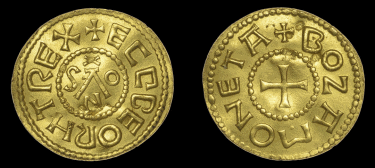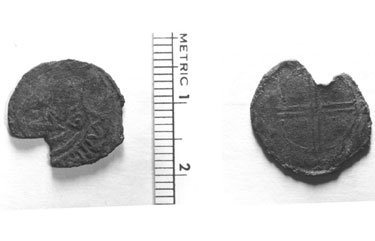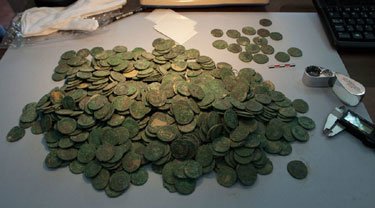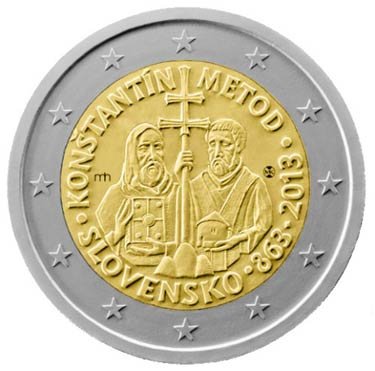Category Archive 'Numismatics'
02 Aug 2021

The Gold Penny or Mancus of 30 Pence, was struck during the time of Ecgberht, King of the West Saxons between 802 and 839.
Evening Standard:
An Anglo-Saxon coin discovered by a metal detectorist is set to fetch up to £200,000 [$277,791.37] at auction.
It was unearthed by a metal detectorist at West Dean, on the Wiltshire and Hampshire border, in March 2020.
Experts say it is the only late Anglo-Saxon gold coin in private hands, with eight other specimens held in institutions – seven at the British museum.
The coin, which weighs 4.82g, is expected to fetch between £150,000 and £200,000 at a sale of coins and historical medals by auctioneers Dix Noonan Webb on September 8.
This coin probably represents a mancus, a gold denomination that first appeared in central and northern Italy, but was current in England already before the year 800.
RTWT
23 Dec 2017


Atlas Obscura:
The story that Guy Mellgren told about the curious silver coin began on the shores of Maine, where he met a stranger named Goddard. In the fall of 1956, Mellgren and Ed Runge, a pair of amateur archaeologists, had come in search of the most basic of coastal dig sites—a shell midden—when they happened onto a more unusual discovery.
Goddard had invited them to explore his shoreline property, and there, on a natural terrace about eight feet above the high tide line, they found stone chips, knives, and fire pits, along with an abundance of other unexpected artifacts. Each summer for many years, Mellgren and Runge returned to excavate the “Goddard Site,†with little help from professional archaeologists. In the second summer, they produced the coin.
For two decades, based on an analysis by a friend in a numismatics club, Mellgren described it as a coin minted in 12th-century England, and no one questioned that identification. The discovery should have been noteworthy—there’s no good explanation for how a medieval English coin could have crossed the Atlantic—but Mellgren never sought wider attention for the find. It was a curiosity to show off to friends and his son’s classmates, until, in 1978, a scrappy regional bulletin published a picture of the coin and an article titled, “Were the English the First to Discover America?â€
That picture found its way to a well-known London dealer, who recognized at once that the coin could not have come from England. Two weeks after Mellgren died, the coin’s reidentification swept into the news. It was a Norse penny, made between 1065 and 1093—evidence for Viking contact with North America centuries before Columbus.
All of sudden, experts from around the world began taking a careful look at the details of Mellgren’s story. Of many objects purported to prove a Viking presence in North America, only the artifacts painstakingly excavated at L’Anse aux Meadows, in Newfoundland, have stood up to investigation. The rest—the Beardmore relics, the Vinland Map, the notorious Kensington Rune Stone—are all considered hoaxes.
Since 1978, no one has questioned that the Mellgren coin is an authentic Norse penny, made in medieval Scandinavia. But 60 years after Mellgren’s find, archaeologists and numismatic experts are still asking how in the world this small, worn coin got to Maine.
RTWT
Hat tip to Glenn Reynolds.
26 Nov 2017


Leicester Mercury:
A metal detectorist has tracked down a rare gold coin from Richard III’s reign near to the site of the Battle of Bosworth.
The Half Angel is one of just a handful of such coins that have survived from the king’s two-year reign.
It was discovered by Michelle Vall while she was taking part in a charity detecting rally in September at Monks Kirby, near the Bosworth Field. News of the discovery has just come to light.
The coin will be auctioned international coins, medals and jewellery specialist Dix Noonan Webb in London on December 13. It is expected to fetch up to £15,000.
Christopher Webb, head of the coins department at Dix Noonan Webb, said: “This is a very rare discovery that has miraculously survived in a field for more than five centuries.
“Its importance as a coin is enhanced by the tantalising possibility that it may have belonged to one of Richard’s army, whose defeat at Bosworth ended the Wars of the Roses and ushered in the Tudor dynasty.”
Michelle, a 51-year-old primary school teaching assistant, from Blackpool, said: “After detecting for two-and-a-half hours in a farmer’s field, I got a signal.
“The coin was deep down, about 16 inches below the surface, and the soil there is thick clay so it took a bit of digging out.
“I spotted this glint of gold in the hole, although I obviously did not know exactly what it was at first. I put it in the palm of my hand and then I went back to the organisers’ tent.
“One of them identified it and people became very excited. That was when I realised that it was a Half Angel.â€
Michelle has decided to sell the coin as, she said, it is “too valuable to keep”.
She added: “I did not want to keep it in a locked cupboard.
“I feel very privileged that I have found something so precious and historic.
“The memory of that day, the excitement not just of myself but also of other detectorists, when I found that beautiful, tiny, piece of historic gold will live with me forever.â€
The Half Angel gold coin was first introduced in 1472 and was half the value of the Angel coin.
The rare gold coin was discovered near the site of the Battle of Bosworth
Richard III issues of the coin are rare because his reign was so brief and there has always been a big interest in items from the controversial king’s rein particularly since his remains were discovered in Leicester in 2012.
It is possible that the coin might have belonged to one of Richard’s soldiers fleeing from the battle that changed the course of English history.
29 Apr 2016


RT News:
Construction workers repairing water pipes in Seville, southern Spain, have discovered 600kg of ancient Roman coins, covered with dirt and dust. The find is said to be worth at least “several million euros.â€
Tens of thousands of bronze coins, dating back to the third and fourth centuries, were found inside 19 Roman amphoras in the town of Tomares near Seville, El Pais reported.
“This find is extremely important,†Ana Navarro, head of Seville’s Archeology Museum now looking after the find, told El Pais. “It is a unique collection, and there are very few similar cases,†she added.
The discovery of the jars full of coins happened on Wednesday during construction work about 10 kilometers from Seville.
“Those are not amphoras meant to store wine or oil. They are smaller and were used to transport other goods. Surprisingly [they were] used to save money,” Navarro told the newspaper.
AFP quoted Navarro as saying the coins, stamped with inscriptions of Emperors Maximian and Constantine on the reverse side, are worth “several million euros.â€
“I could not give you an monetary value, because the value they really have is historical and you can’t calculate that.â€
Although most coins are bronze, archaeologists say some appear to be silver-plated. “Most show little evidence of wear, which means they were not in circulation,” Navarro explained.
“It is surprising to have found 19 jars filled with coins. Out hypothesis is that the money was used to pay imperial taxes or paying the army,†Navarro told the newspaper, adding that the amphoras were probably hidden “because of social conflicts, violence [and other] threats.â€
Local authorities have suspended work on the water pipes to carry out archaeological excavations at the site.
11 Dec 2015


Telegraph:
A Viking hoard discovered by an amateur metal detectorist could prompt the re-writing of English history, after experts claimed it shows how Alfred the Great “airbrushed†a rival king from history.
Ceolwulf II of Mercia is barely mentioned in contemporary records and largely forgotten by history, only briefly described in the Anglo-Saxon Chronicle as an “unwise King’s thaneâ€.
The hoard was found by James Mather, a metal detectorist, near Watlington in OctoberThe hoard was found by James Mather, a metal detectorist, near Watlington in October Photo: Julian Simmonds/The Telegraph
But as of today, his reputation might be rescued after a haul of coins dug up after more than 1,000 years suggested he in fact had a powerful alliance with Alfred, ruling their kingdoms as equals.
The hoard, made up of 186 coins, seven items of jewellery and 15 ingots, was found by amateur metal detectorist James Mather on his 60th birthday, after he uncovered it in a muddy field.
Guardian story

27 Nov 2012


The religious-symbol-neutered version previously scheduled for production.
Original story
After strong objections by the Catholic Church which were taken up in the national parliament of Slovakia by the Christian Democratic Movement (KDH), Slovak Democratic and Christian Union (SDKÚ) and some representatives of the Ordinary People and Independent Personalities (OĽaNO) caucus to the elimination of halos from the heads of Sts. Cyril and Methodius and the removal of the image of the cross from the saints’ vestments, the Board of Directors of the National Bank of Slovakia has announced that the halos and crosses will be restored on the 2-Euro coins scheduled to be released in 2013 to commemorate the 1150th Anniversary of the Mission of Cyril and Methodius to the Slavs.
Slovak Spectator reported, however, that restoring those halos might preclude the Slovakian €2 coin being released throughout the European Union.
The NBS [National Bank of Slovakia, country’s central bank – ed. note] Bank Council approved the original proposal of the design, even though it realises that the new approval process may lead to frustrating the original goal of releasing the commemorative coin throughout the 17-nation eurozone,†said spokesperson for the bank Petra Pauerová, as quoted by TASR.
The European Commission earlier stated that the commemorative coin cannot contain crosses and halos in order to observe the principle of religious neutrality in the European Union. Later it was revealed that it was not the EC as such, but certain eurozone members that objected to releasing the coin with religious symbols.
—————————-
The same paper separately identified the countries who had a problem with Christian saints being depicted with such particularist Christian symbols as halos and crosses/
It was certain eurozone member states that expressed disagreement with the original artistic proposal for a Slovak commemorative coin depicting Saints Cyril and Methodius with crosses and halos set to be released in 2013, Andrej Králik from the Representation of the EU Commission in Slovakia said on Thursday, November 22.
The commission subsequently asked Slovakia to submit a modified proposal, which was later approved by the EU Council, Králik told the TASR newswire. He rejected statements by certain Slovak politicians who said that the case involved a ‘dictate of Brussels’ and ‘high-handedness of officials from the EU Commission’, describing these assertions as untrue and deceptive.
The commission stated that the removal of the religious symbols was due to the need to observe religious neutrality, as set out in the Charter of Fundamental Rights of the EU. German MEP Martin Kastler earlier on Thursday revealed that the countries that had raised objections to the original Slovak proposal were France and Greece
17 May 2012


The Daily Mail:
A $3 cold coin is expected to fetch $4 million when it goes up for auction next month.
The 1870-S is one of just two ever made and is one of the rarest coins in US history.
It was discovered in a San Francisco bookshop in 1997 by a European tourist, who found it glued to the inside pages of a souvenir book.
The collector sat on his unbelievable find for 15 years, before bringing it to auction at the Four Seasons Auction Gallery outside Atlanta, Georgia.
The coin was produced by the San Francisco mint on special order of the mint superintendent, originally meant to be placed in the cornerstone of a building in the city.
It was made from a special cast that had a unique ‘S’ hand-carved into it. The ‘S’ is what makes the coin so rare.
When the coin in the cornerstone was damaged and removed, a second copy was cast.
That duplicate is on display at the American Numismatic Association Museum in Colorado Springs, Colorado. In 2007, it was valued at $4 million.
Appraisers aren’t certain of the origin of the coin that is going on the auction block next month.
It could be the original that was taken from the cornerstone of the building. Or, it could be a third copy that was made and never reported.
photos of book & coin
I’ve found old stamps, stock certificates, and letters and inscriptions from famous people (Lord Grey of Fallodon and Siegfried Sasoon) in old books myself.
Your are browsing
the Archives of Never Yet Melted in the 'Numismatics' Category.
/div>

Feeds
|











